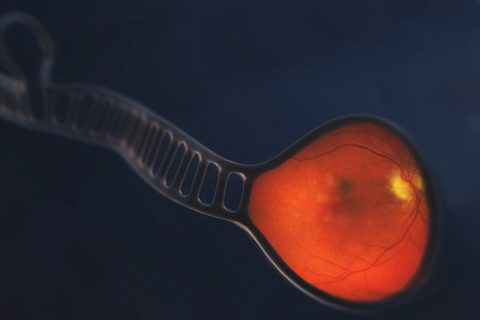A new review by researchers of the University of Eastern Finland and University of Lodz reveals insights into the potential drivers of a currently incurable eye disease, age-related macular degeneration (AMD).
Weakening of the intracellular clearance mechanism, autophagy, has been linked to the pathogenesis of AMD. Autophagy is controlled by several microRNAs (miRNAs) which are dysregulated in subjects with AMD. Thus, manipulation of the expression of these miRNAs could offer new approaches in AMD prevention and treatment, according to a review published in a top open-access journal in the field of ageing, Ageing Research Reviews.
Five things to know about AMD and miRNAs
Below, you can find five questions on this topic answered by the authors, Dr. Juha Hyttinen, Dr. Szabolcs Felszeghy and Professor Kai Kaarniranta, who led the project along with the distinguished collaborator Professor Janusz Blasiak from Poland. Kaarniranta is a Professor of Ophthalmology and the head of the AMD Lab at the University of Eastern Finland and Kuopio University Hospital.
What is AMD?
Age-related macular degeneration causes currently irreparable damage to the macula, which leads to the loss of central vision (the sharp, fine detail, “straight ahead” vision) that is required for common daily tasks such as reading, driving, and seeing the world in color. See the video on AMD Lab’s homepage (at 1:26-1:29) for an example of what the change might look like: Kaarniranta AMD Lab – UEF Connect .
AMD can be divided into two different categories – dry and wet – depending on disease progression. Currently, wet AMD can be treated with intravitreal injections. However, they are not curative, and loss of vision may progress despite treatment.
With the ageing of the world’s population, medical science is under ever greater pressure to find ways to help treat age-related conditions. AMD is now the third largest cause of blindness globally, and the leading cause of blindness in ages 55 and older. Its prevalence is expected to increase along with the global aging of the population, a figure expected to triple in the next 25–30 years.
What are miRNAs?
MicroRNAs (miRNAs) are short RNA molecules 17 to 25 nucleotides in size that regulate post-transcriptional silencing of their target genes. A single miRNA can target hundreds of mRNAs (messenger ribonucleic acids, single-stranded RNA molecules) that play a vital role as they carry genetic code from DNA in the cell’s nucleus to ribosomes, the cell’s protein-making machinery. The expression of many genes involved in functional interacting pathways is influenced by miRNAs. It has been shown that miRNAs are involved in the pathogenesis of many different diseases, including cancers, cardiovascular and neurodegenerative diseases and AMD. The majority of the miRNAs related to AMD have been found to be increased.
How do miRNAs work on AMD?
Their impact is seen mainly via autophagy, particularly macroautophagy, a mechanism vital for intracellular quality control and homeostasis. In the past ten years, a huge number of studies have reported that miRNAs affect the careful regulation of autophagy. Most of the miRNAs that have been reported to be related to AMD possess effects on the different phases of autophagy: induction, nucleation, elongation, completion, fusion and degeneration.
How can miRNAs be used to combat AMD in the future?
“New approaches can be considered to deal with undesired changes in the expression of autophagy-related miRNAs in AMD. More specifically, when we know that a pro-autophagic miRNA is downregulated or an anti-autophagic miRNA is upregulated, a suitable therapy could be chosen to correct the resulting imbalance,” says Felszeghy, molecular morphologist of the Kaarniranta AMD lab.
“Of course, the fact that a single miRNA can modify the expression of multitudes of mRNAs needs be taken into account when developing new miRNA therapies against AMD. Effective treatment may require the administration of several synthetic miRNAs called agomirs or miRNA inhibitors called antagomirs, since there are oftentimes multiple dysregulated miRNAs. As the complicated molecular regulation of autophagy still requires further clarification in many of its aspects, the effects of individual miRNAs on the various molecular pathways need to be investigated in detail.”
How close are we to real life miRNA therapy?
“For the majority of miRNAs that have been discussed in our review, there is no existing animal model data of whether they have beneficial effects against AMD. This will need to be investigated in the future. This is also why we have provided information on miRNAs that may be associated with AMD pathogenesis through their involvement in autophagy dysregulation,” Dr. Juha Hyttinen notes.
“Looking ahead, with our partners — researchers, clinicians, and patient groups — around the world, we aim to combine our in-depth understanding of AMD biology with new translational data and analytical sources to enrich the patients’ visions in the future. We believe this work might help launch the era of personalized medicine in the treatment of AMD,“ Kaarniranta adds.
His AMD Lab conducts evidence-based translational research programs and has a network of more than 40 principal investigators working across the globe in more than 30 institutes, centres and departments.
For further information, please contact:
Professor Kai Kaarniranta https://uefconnect.uef.fi/en/person/kai.kaarniranta/
Dr. Juha Hyttinen https://uefconnect.uef.fi/en/person/juha.hyttinen/
Dr. Szabolcs Felszeghy https://uefconnect.uef.fi/en/person/szabolcs.felszeghy/
Kaarniranta Lab’s home page: https://www.kaarnirantalab.fi/
Hyttinen, Juha M.T.; Błasiak, Janusz; Felszeghy, Szabolcs;, Kaarniranta, Kai. MicroRNAs in the regulation of autophagy and their possible use in age-related macular degeneration therapy. Ageing Research Reviews, in press, 2021. https://doi.org/10.1016/j.arr.2021.101260
Open access: https://www.sciencedirect.com/science/article/pii/S1568163721000076


